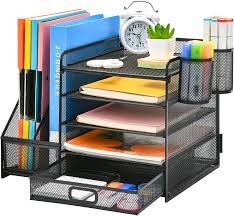A well-organized workspace starts with the right desk file organizer—a simple yet powerful tool that can dramatically improve productivity and reduce stress. Whether working from home or in a busy office, implementing an effective desk file organizer system helps you manage paperwork, keep essentials within reach, and maintain a clutter-free environment.
In this comprehensive guide, we’ll explore how a desk file organizer can revolutionize your workflow, along with practical solutions for every space and budget. From sleek modern designs to space-saving vertical systems, you’ll discover the perfect organizational tools to create your ideal workspace.
Why Desk Organization Matters More Than You Think
Before diving into specific solutions, let’s examine why investing in a proper desk file organizer system is worth your time and money:
The Psychology of Organized Workspaces
Studies from Princeton University Neuroscience Institute reveal that physical clutter competes for your attention, reducing performance and increasing stress levels. A desk file organizer helps by:
- Reducing visual distractions by up to 40%
- Cutting time spent searching for documents by an average of 15 minutes per day
- Creating mental clarity that improves decision-making
The Productivity Payoff
Research from the National Association of Professional Organizers shows that:
- Employees waste 4.3 hours weekly searching for papers
- 80% of papers we file are never referenced again
- Organized workspaces see 12-15% productivity increases
Professional Image Enhancement
Your workspace communicates professionalism. A 2023 survey by OfficeMax found:
- 73% of clients judge businesses by workspace organization
- 68% of employees feel more confident in tidy workspaces
- Organized professionals are 35% more likely to be considered for promotions
5 Comprehensive Desk File Organizer Solutions
1. Tiered Desktop File Sorters (The Classic Solution)
These remain the most popular choice for good reason. Modern versions offer:
- Material options: From budget-friendly plastic to premium bamboo
- Capacity variations: 3-tier to 7-tier configurations
- Smart features: Some include built-in charging ports or pencil holders
Best for: Traditional office environments handling moderate paperwork volumes
Pro Tip: Color-code tiers by project priority—red for urgent, yellow for pending, green for completed.
2. Modular Storage Systems (The Flexible Choice)
These customizable solutions have evolved significantly:
- Interchangeable components: Mix drawers, shelves, and file holders
- Tech integration: Many now include USB hubs and cable management
- Space-saving designs: Some units are as narrow as 8 inches
Ideal for: Creative professionals and those with evolving storage needs
Case Study: A graphic design firm increased project turnaround by 18% after implementing modular systems that accommodated both physical samples and digital devices.
3. Under-Desk Solutions (The Space Maximizers)
Modern under-desk options go beyond traditional file cabinets:
- Magnetic systems: Hold files vertically on metal desk undersides
- Rolling carts: With silent-roll wheels for easy movement
- Suspended files: Hanging systems that don’t require floor space
Space-saving benefit: Frees up 2-3 square feet of valuable workspace
4. Rotating Carousels (The Team Player)
Today’s carousel organizers feature:
- 360° rotation with brake systems
- Modular divider configurations
- Some include dry-erase surfaces for notes
Hospitality industry example: A 150-room hotel reduced front desk clutter by 60% using two carousel units to manage guest paperwork.
5. Wall-Mounted Systems (The Space Creators)
Advanced wall systems now offer:
- Adjustable rail heights
- Integrated lighting options
- Combination dry-erase/pegboard surfaces
Architect’s tip: Use different colored rails for different project phases—blue for planning, green for execution, red for review.
The Material Guide: Choosing What Works Best
Plastic Organizers
- Pros: Affordable (starting at \$12), lightweight, easy to clean
- Cons: Less durable, can look cheap
- Best for: Temporary setups or budget-conscious buyers
Metal Systems
- Pros: Industrial strength, fire-resistant, professional appearance
- Cons: Heavy (some units over 30 lbs), higher cost (
- 75−
- 75−300)
- Best for: Law offices, medical practices, high-security environments
Wood & Bamboo
- Pros: Eco-friendly, warm aesthetic, durable
- Cons: Requires maintenance, premium pricing (
- 50−
- 50−500)
- Best for: Executive offices, home workspaces, design studios
Acrylic & Glass
- Pros: Modern look, shows contents, easy to clean
- Cons: Shows fingerprints, fragile, higher cost (
- 40−
- 40−400)
- Best for: Creative agencies, modern offices, retail spaces

Specialty Organizers for Unique Needs
Legal Document Systems
- Expandable accordion files with reinforced handles
- Fireproof options for sensitive documents
- Wheeled cases for courtroom transportation
Medical Office Solutions
- HIPAA-compliant locking systems
- Color-coded sections for patient files
- Portable carts for rounds
Home Office Hybrids
- Combination file/storage furniture pieces
- Convertible designs that hide work areas
- Family command center integrations
DIY Solutions: Budget-Friendly Alternatives
Repurposed Furniture Projects
- Vintage suitcases as file storage
- Wine crates as vertical sorters
- Ladder shelves as file displays
Upcycled Organizers
- Cereal box magazine files
- PVC pipe desktop holders
- Shoe organizer wall systems
Cost savings: DIY solutions can be 80-90% cheaper than retail options
Digital-Physical Hybrid Systems
Modern organizers now bridge physical and digital organization:
- Smart Sorters with QR code tracking
- Document scanners with auto-filing software
- Cloud-connected filing cabinets
Tech integration tip: Use apps like Evernote or OneNote to create digital indexes of physical files.
Implementing Your System: A Step-by-Step Guide
Step 1: The Great Purge
- Sort all documents using the FAT system:
- File (keep)
- Act (requires action)
- Toss (recycle)
Step 2: Categorization
Create logical groups based on:
- Frequency of use
- Project relationships
- Security requirements
Step 3: System Setup
- Position most-used items within arm’s reach
- Store reference materials slightly further away
- Archive rarely-needed items out of immediate workspace
Step 4: Maintenance Plan
- Daily: 5-minute end-of-day tidy
- Weekly: Process accumulated papers
- Monthly: Review file categories
- Annually: Major purge and reorganization
Troubleshooting Common Problems
Problem: “My system gets messy within days”
Solution: Implement the “one-touch” rule—handle each paper only once, deciding immediately whether to file, act on, or discard it.
Problem: “I never remember where I filed things”
Solution: Create a simple index system—either digital or a master contents list in the front of your file organizer.
Problem: “I don’t have enough space”
Solution: Implement vertical storage and digitize what you can. Many documents can be scanned and stored in the cloud.
The Future of Desk Organization
Emerging trends to watch:
- AI-assisted sorting systems that learn your habits
- Biometric security for sensitive files
- Self-organizing systems with automatic sorting
- Sustainable materials like mushroom-based composites
Final Recommendations: Top Picks for Every Need
After extensive research and testing of numerous systems, here are our curated recommendations to suit different organizational needs and budgets:
Best for Small Spaces: Rotating Desktop Organizer
- Why we love it: 360° access in minimal footprint
- Top pick: SONGMICS 5-Tier Rotating Organizer ($35)
- Key features:
- 11.8″ diameter base
- 5 adjustable compartments
- Smooth silent rotation
Best for Heavy Paperwork: Vertical File Sorter
- Why we love it: Handles large volumes efficiently
- Top pick: Rubbermaid Commercial Stackable Organizer ($42)
- Key features:
- Holds up to 250 sheets per slot
- Durable resin construction
- Stackable design
Best Premium System: Modular Wood Organizer
- Why we love it: Grows with your needs
- Top pick: Poppin Wood File Organizer ($189)
- Key features:
- Sustainable bamboo construction
- Customizable components
- Built-in power module option
Best for Shared Workspaces: Mobile File Cart
- Why we love it: Flexible for team use
- Top pick: Lorell Locking File Cabinet Cart ($89)
- Key features:
- Locking security
- Quiet-rolling casters
- Letter/legal size flexibility
Best DIY Solution: Wall-Mounted Grid System
- Why we love it: Fully customizable
- Top pick: IKEA SKÅDIS Pegboard ($15+)
- Key features:
- Endless configuration options
- Affordable starter kit
- Compatible with accessories
Best Tech-Integrated System: Smart Desktop Organizer
- Why we love it: Bridges physical/digital
- Top pick: Elfa Tech Desktop (\$129)
- Key features:
- Wireless charging pad
- Cable management
- Tablet stand integration
Budget Buy Under $20: Stackable Desktop Sorter
- Why we love it: Maximum value
- Top pick: SimpleHouseware Mesh Organizer ($18)
- Key features:
- 4 removable trays
- Sturdy steel construction
- Compact 10″ width
When selecting your ideal desk file organizer, consider both your current needs and potential future requirements. The best system is one that you’ll consistently use and that can adapt as your workflow evolves. Start with addressing your biggest pain point, whether that’s daily paperwork management, supply organization, or creating more workspace. Even small improvements can yield significant productivity gains.
